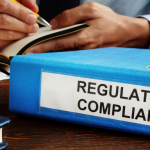Executive Summary
-
Artificial Intelligence (AI) is transforming the landscape of regulatory compliance in the financial sector.
-
Automation of routine compliance tasks reduces human error and increases efficiency.
-
AI tools offer real-time monitoring and predictive analytics for proactive risk management.
-
Challenges include data privacy concerns and regulatory adaptation to AI technologies.
-
Experts recommend a strategic integration of AI with human oversight for optimal results.
Introduction
In the fast-paced world of finance, regulatory compliance is a critical concern. The complexity and volume of regulations can overwhelm even the most diligent organizations. Enter Artificial Intelligence (AI), a game-changer in streamlining these compliance processes. This article explores how AI is revolutionizing regulatory compliance in finance, offering a competitive edge to firms that leverage it effectively. You’ll discover the benefits, challenges, and strategic insights for integrating AI into your compliance framework.
Definitions / Context
Regulatory Compliance: This refers to the adherence to laws, regulations, guidelines, and specifications relevant to business processes. Non-compliance can lead to legal penalties and financial losses.
Artificial Intelligence (AI): AI involves the simulation of human intelligence processes by machines, especially computer systems. These processes include learning, reasoning, and self-correction.
Benefits / Pros
-
Automation of Routine Tasks
AI can handle repetitive compliance tasks, reducing human error and freeing up human resources for more strategic activities. -
Real-Time Monitoring
AI systems can continuously monitor transactions and flag suspicious activities, enhancing risk management. -
Predictive Analytics
By analyzing historical data, AI can predict potential compliance breaches, allowing proactive measures. -
Cost Efficiency
Reducing manual workload and error rates lowers operational costs in the long run.
Risks / Cons / Challenges
-
Data Privacy Concerns
The use of AI in processing personal data raises significant privacy issues that need addressing. -
Regulatory Adaptation
Existing regulations may not fully accommodate AI technologies, requiring updates and clarifications. -
Dependence on Technology
Over-reliance on AI can lead to vulnerabilities if systems fail or are compromised.
Step-by-Step Process
How to Integrate AI into Compliance
-
Assessment of Needs
Identify areas within your compliance framework that could benefit from AI integration. -
Selection of AI Tools
Choose AI solutions that align with your specific compliance requirements. -
Implementation
Deploy AI systems with careful planning and testing to ensure alignment with compliance goals. -
Monitoring and Adjustment
Continuously monitor AI performance and make necessary adjustments to optimize efficiency.
A leading bank implemented an AI-driven compliance system that reduced false-positive alerts by 40%. This system utilized machine learning algorithms to refine transaction monitoring, resulting in improved accuracy and significant cost savings.
Expert Tips / Strategic Insights
-
Human-AI Collaboration
Experts like John Doe from Epiidosis suggest combining AI capabilities with human oversight to ensure accountability and accuracy. -
Continuous Learning
Regularly update AI models with new data to maintain their effectiveness and relevance. -
Regulatory Engagement
Engage with regulators early and often to align AI implementations with evolving compliance standards.
Tools / Resources / Calculators
-
RegTech Solutions
Explore platforms like ComplyAdvantage for AI-driven compliance tools. -
AI Compliance Checklists
Downloadable checklists for assessing AI integration readiness in compliance. -
Webinars and Workshops
Participate in industry events to stay informed on the latest AI compliance trends.
Conclusion
AI is undeniably transforming regulatory compliance in finance, offering significant benefits in efficiency, accuracy, and predictive capabilities. However, careful implementation and ongoing oversight are crucial to maximizing these benefits while mitigating associated risks. For those looking to stay ahead of the curve, integrating AI into your compliance strategy is not just an option—it’s a necessity.


















